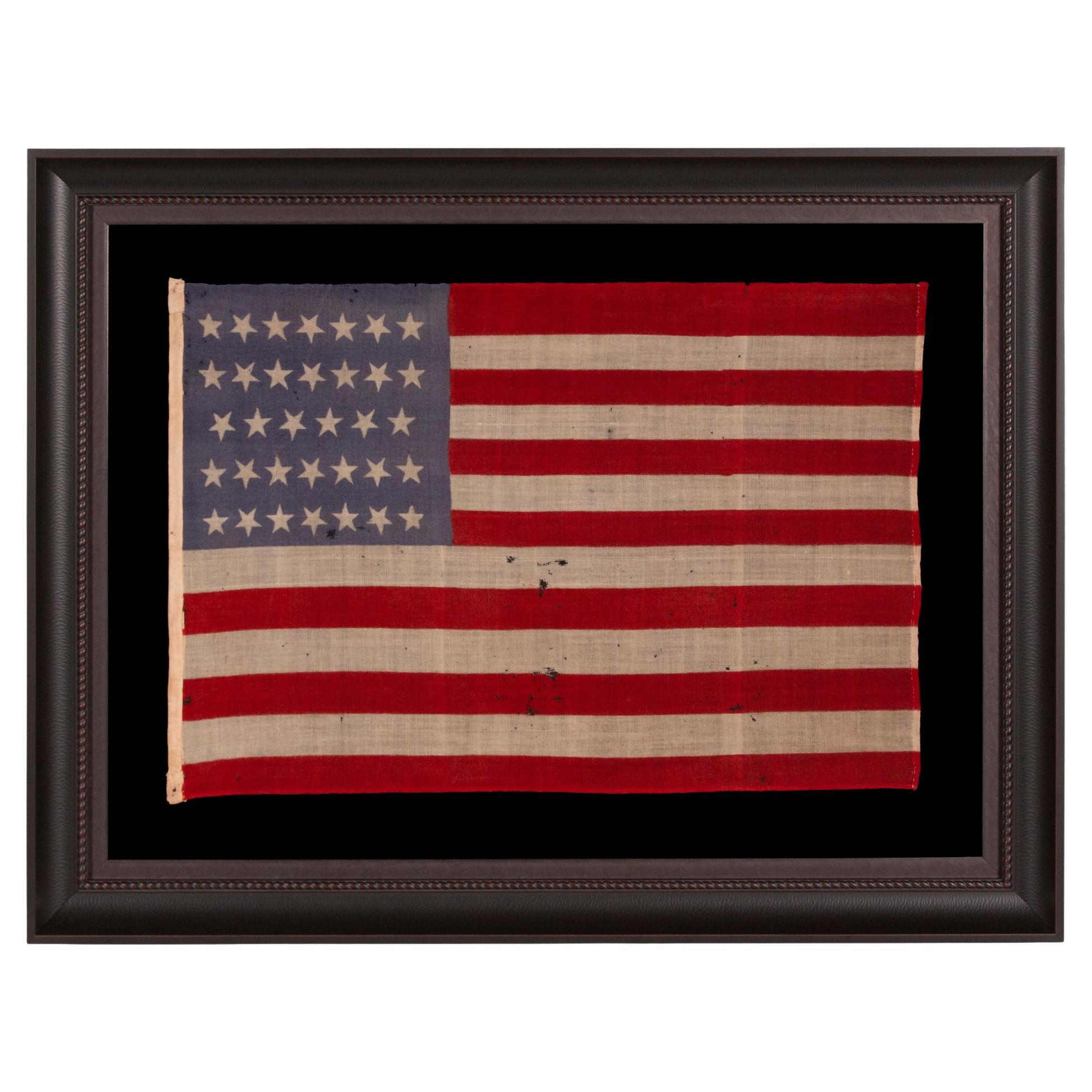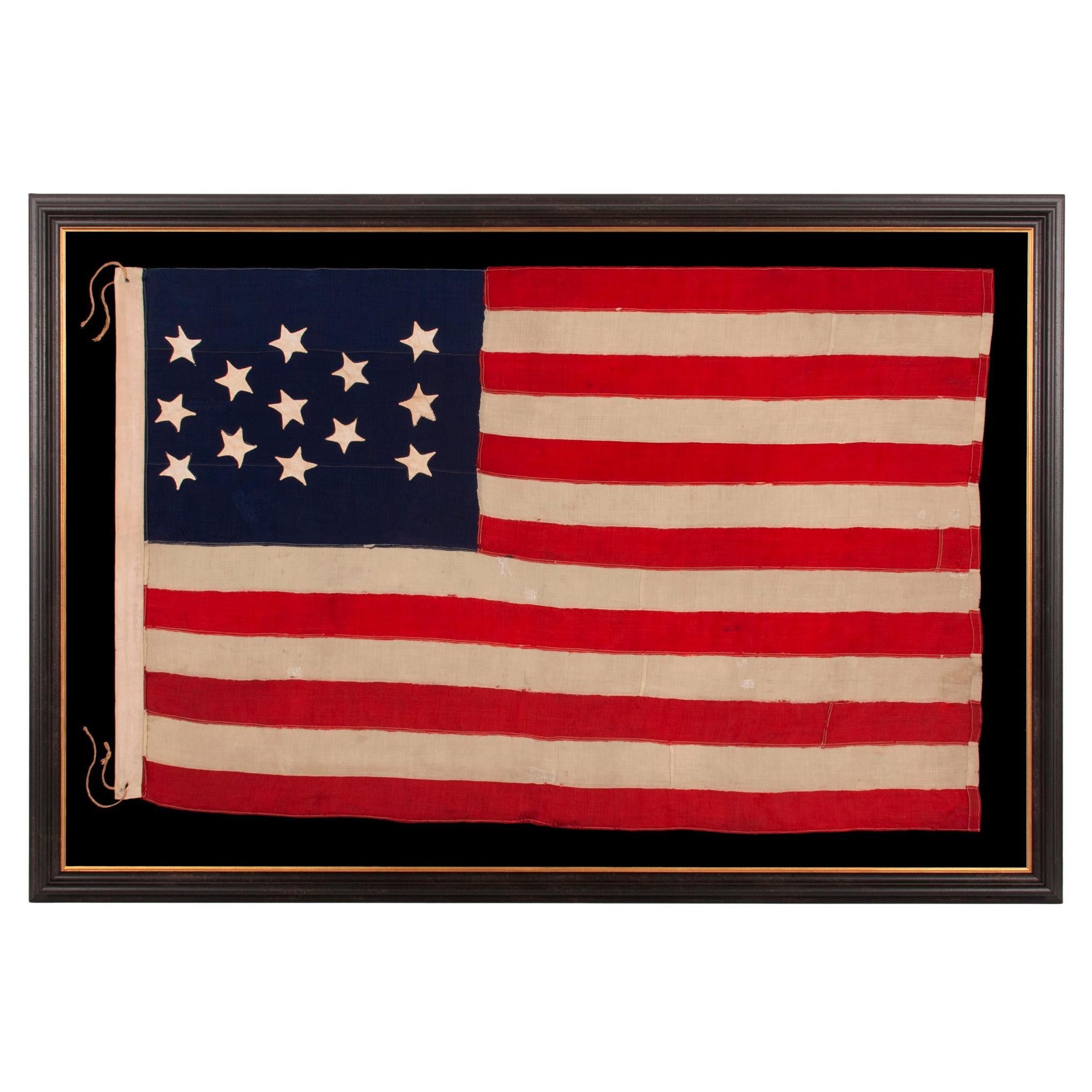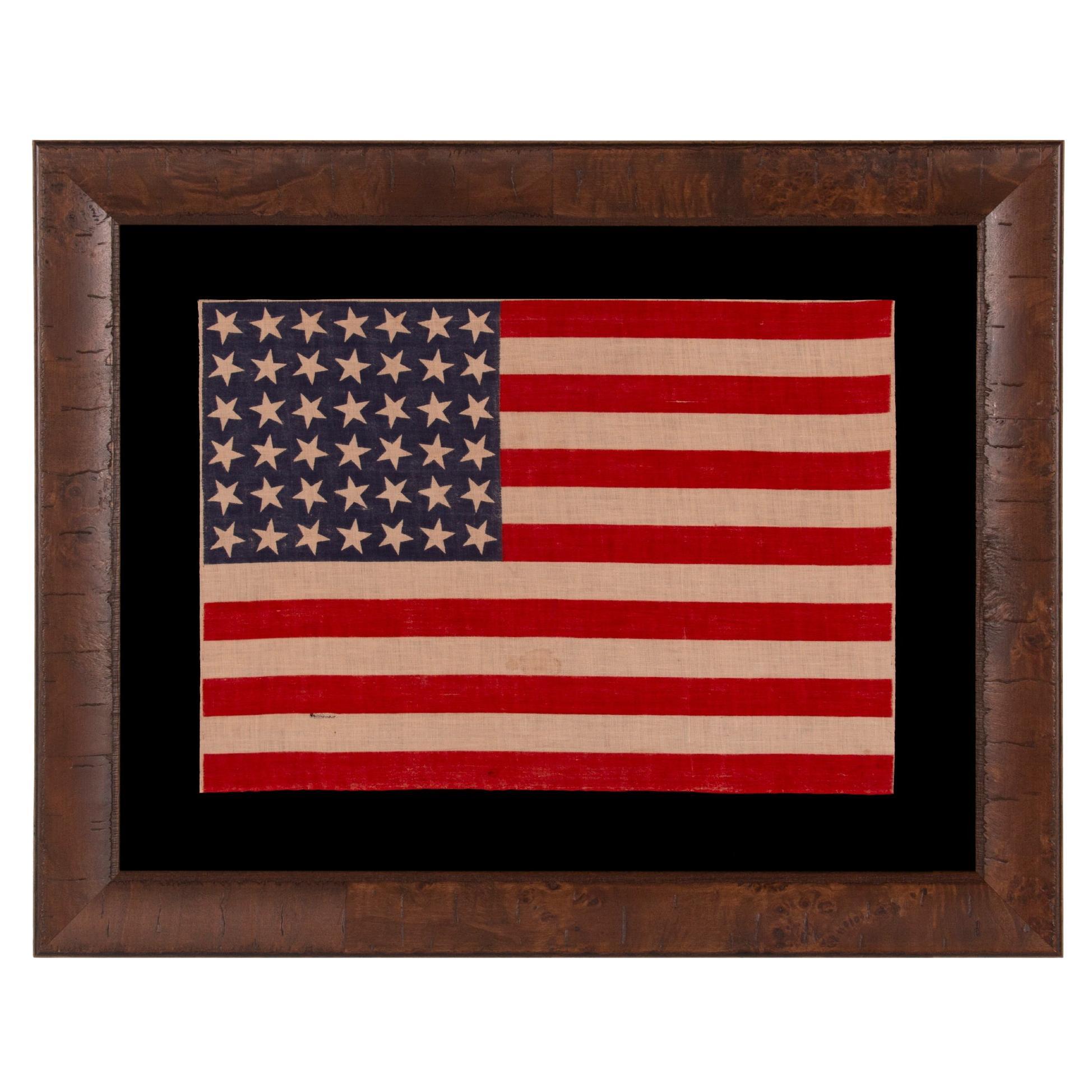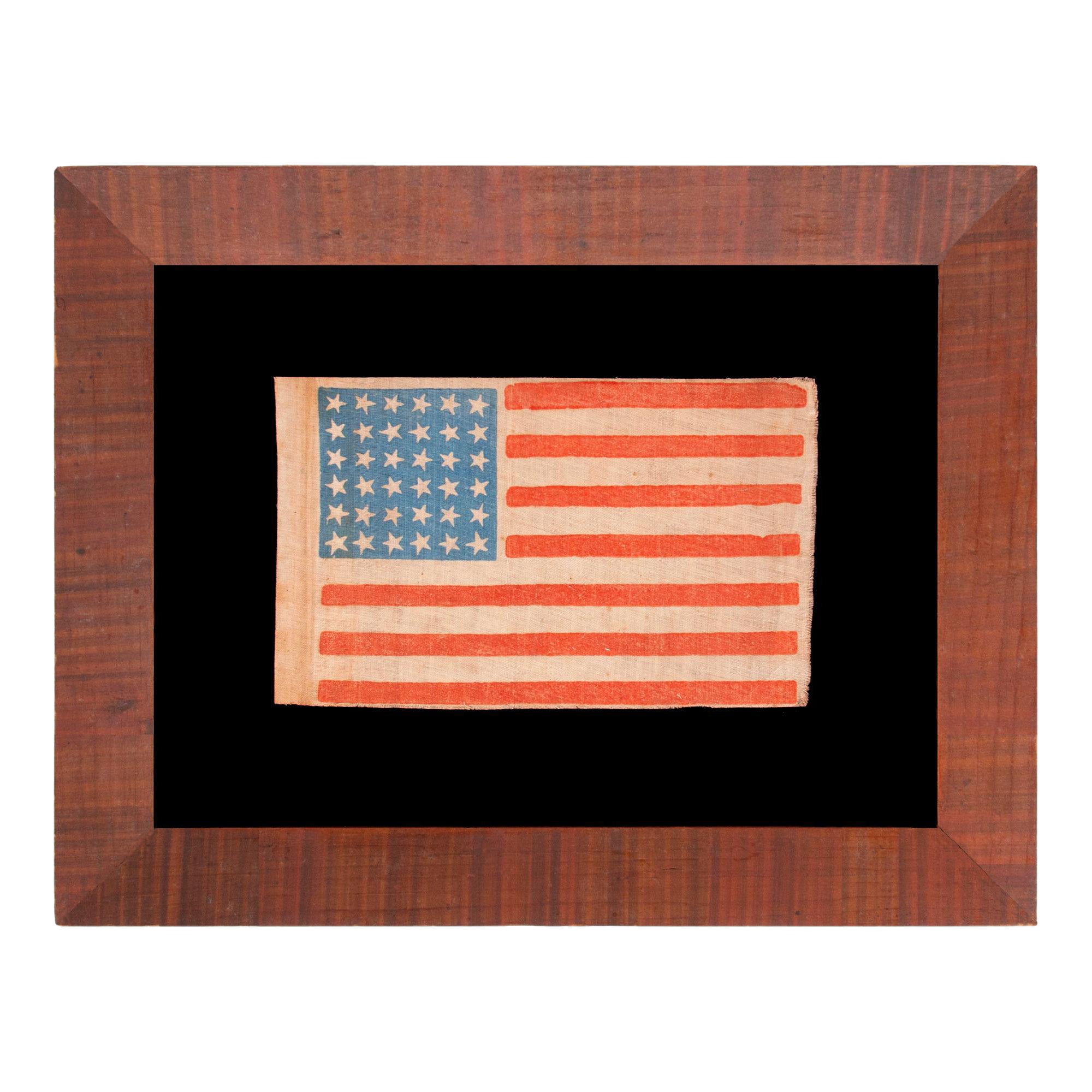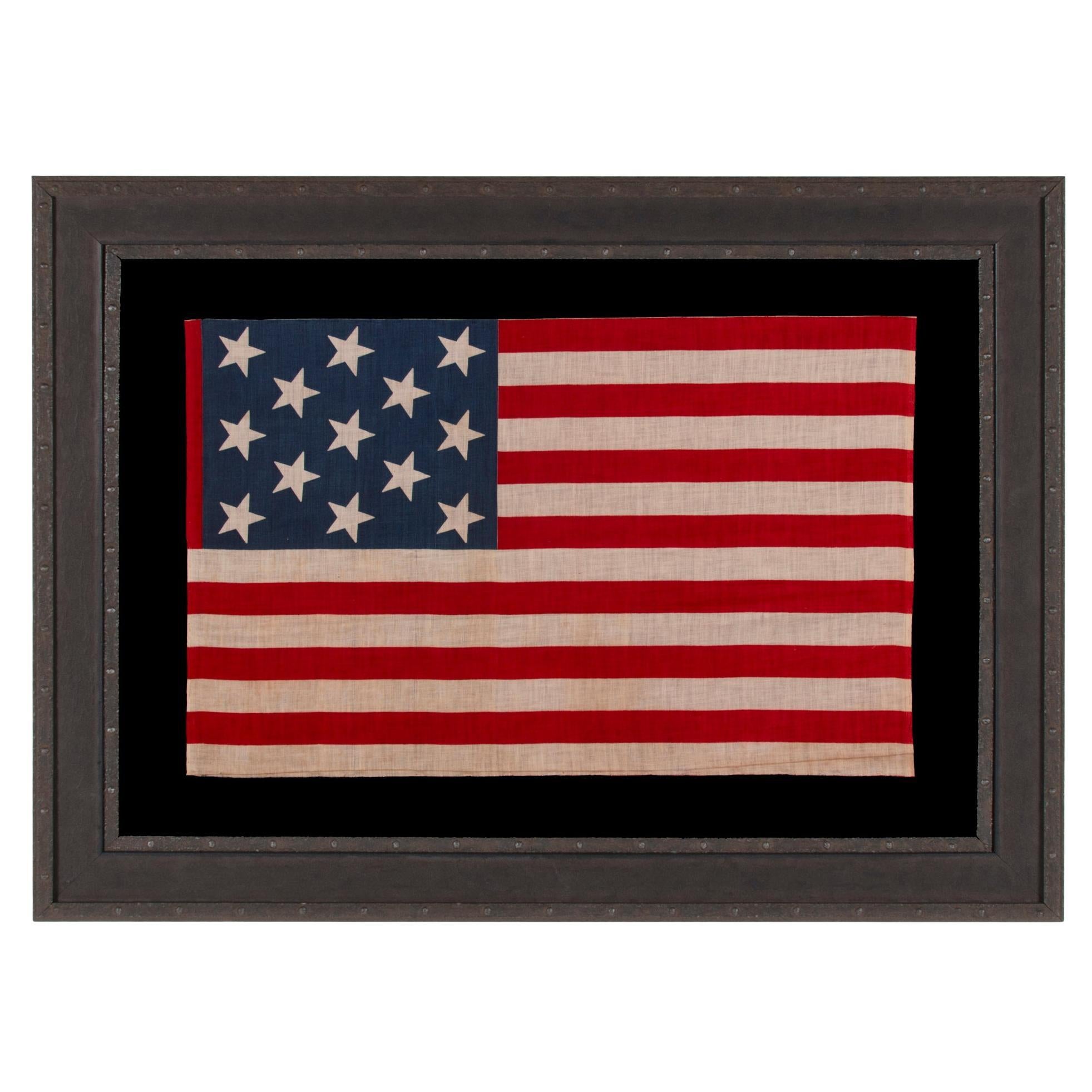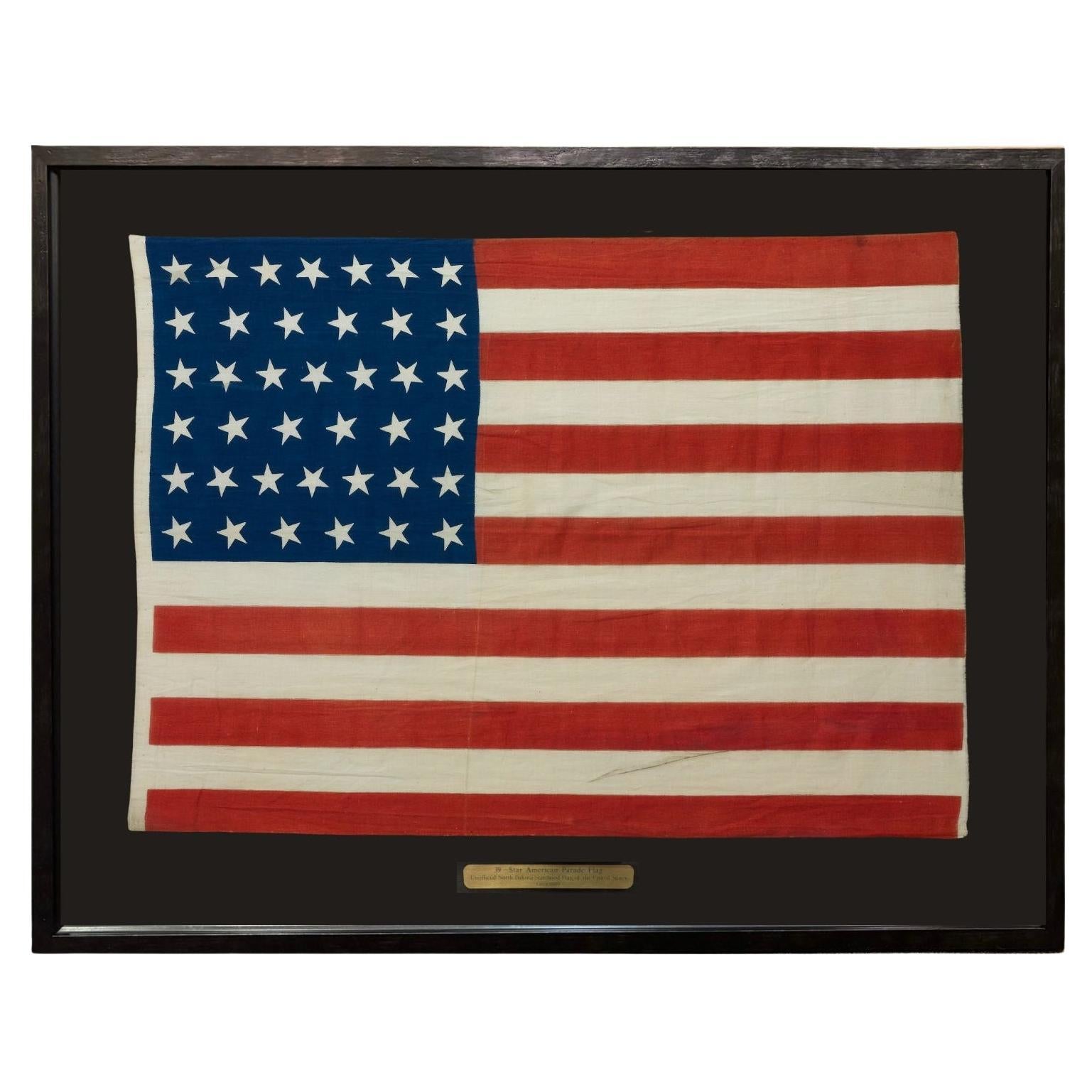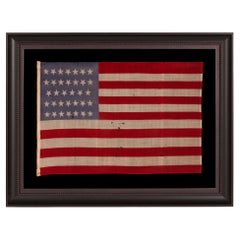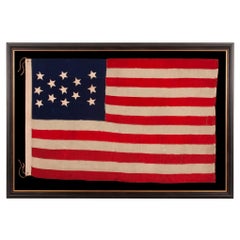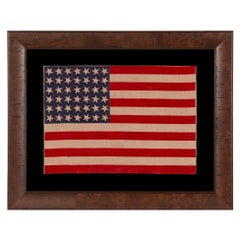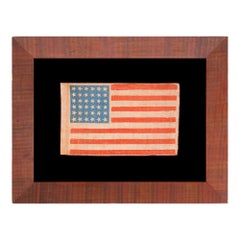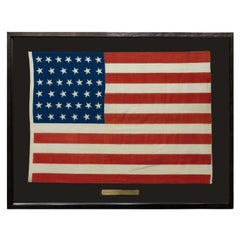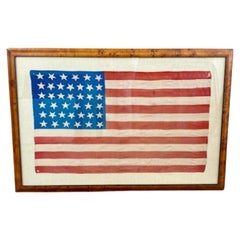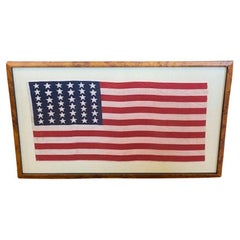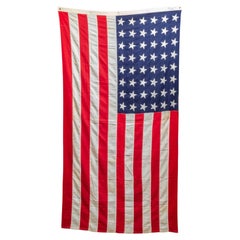Items Similar to 42 Hand Sewn Stars on An Antique American Flag ca 1889-1890
Want more images or videos?
Request additional images or videos from the seller
1 of 6
42 Hand Sewn Stars on An Antique American Flag ca 1889-1890
Price Upon Request
Price Upon Request
Price Upon Request
Price Upon Request
Price Upon Request
Price Upon Request
Price Upon Request
Price Upon Request
Price Upon Request
Price Upon Request
About the Item
42 HAND-SEWN STARS ON AN ANTIQUE AMERICAN FLAG WITH A TWO-TONE, DUSTY BLUE CANTON, REFLECTS THE ADDITION OF WASHINGTON STATE, MONTANA, AND THE DAKOTAS, NEVER AN OFFICIAL STAR COUNT, circa 1889-1890
42 star American national flag with hand-sewn stars that display especially nice graphic qualities and beautiful coloration.
The 42 star flag is interesting from a historical perspective, both because 42 was never an official star count, and because 42 star flags were only produced for about 8 months. The flag represents the addition of the Dakotas, Montana, and Washington State, between November 2nd and November 11th, 1889. The 42nd state was officially Washington, but the four states gained their statehood only nine days apart, and flag makers added 4 stars, accordingly, to the count of 38 that was official at the time.
After the Third Flag Act, passed by Congress in 1818, star counts became official each year on the 4th of July. At this time, a new star was added for every state that had entered the Union over the preceding “flag year” (July 4th – July 3rd). Flag makers did not generally wait for Independence Day and “official” star counts, however, especially during the late 19th century. On many occasions the number of territories becoming states was instead speculated, and stars were added before the respective states were even in. Flag-making was a competitive industry, and no one wanted to be making 38 star flags, for example, when their competitors were making 42’s, especially when there were 42 states. It was for this reason that 42 star flags were produced by numerous makers, primarily between November of 1889 and July of 1890.
On July 3rd, 1890, Idaho was admitted as the 43rd state, just one day before 42 would have become the new official count. Interestingly enough, the 43 star flag, while official for 1 year, was for all practical purposes not produced, because the 44th state was coming and flag-makers seem to have been well aware of the news. Production of 43 star flags was therefore basically skipped, in favor of making flags in the 44 star count to represent the addition of Wyoming on July 10th. The existence of 42 star flags reflects a classic display of both American capitalism and expansionist ideals for the growth of the nation.
The stars of the flag are arranged in 6 rows of 7. These are made of cotton, hand-sewn, and double-appliquéd (applied to both sides). Although it appears to have been the intent of the maker to orient all of the stars with one point directed upward, note how their profiles vary greatly throughout the arrangement, some bulbous and others less-so, with arms bent this way and that, so that many irregularities are displayed within their homemade qualities. This adds a nice element of folk quality to the flag’s design.
The canton and stripes are made of wool bunting that has been pieced with treadle stitching. Note how the coloration of the canton has faded to a dusty blue-grey. When this trait is found in this particular weave of blue bunting, it is most often in flags that date between 1885 and 1895, and more often in the second half of that ten-year date bracket. After 1895, either flag manufacturers caught on to the fugitive dye and ordered different wool, or the textile company that was producing it changed the dying process. In any event, flags that were made with this wool and have survived to the present have an interesting presentation that many collectors find attractive.
Also note how the latter was pieced in two segments. Fabric of this type—produced uniquely for the manufacture of flags and banners—generally came in a width of 18 inches. Anything requiring a larger panel than this had to be pieced from multiple lengths of cloth. In this instance, the difference in color reflects the use of wool bunting from two different dye lots, one of which faded more aggressively than the other. The resulting differential would not have been noticeable initially and, though unintentional, is actually of greater visual interest than one might expect, contributing an unusual trait that assists in the translation of its age.
There is a sailcloth canvas binding along the hoist end with 2 brass grommets, one each at the extreme top and bottom.
In the 19th century, flags with sewn construction (as opposed to printed) were typically eight feet long or larger. Because flags needed to be seen and recognized from a great distance, size was of particular importance to their function as signals. A length of six feet on the fly was considered small and production of flags smaller than this was extremely limited. Because the average 19th century sewn flag can be cumbersome to frame and display in an indoor setting, many collectors prefer printed parade flags, which were generally 3 feet long and smaller, as well as small-scale sewn flags, like this one.
Mounting: For 25 years we have maintained a specialized department for this purpose. Our lead conservator holds a master's degree in textile conservation from one of the nation’s top university programs. We take great care in the mounting and preservation of flags and related textiles and have preserved thousands of examples.
The background is 100% cotton twill, black in color, that has been washed and treated for colorfastness. The mount was placed in a black-painted, hand-gilded and distressed Italian molding. The glazing is U.V. protective acrylic (Plexiglas).
Condition: There are very minor losses in limited areas throughout, accompanied by minor to modest of the same in the canton, as well as in the 1st, 7th, 9th and 10th stripes. There a moderate patched hole near the beginning of the 4th stripe and a moderate hole near the center of the 10th stripe. Fabric of similar coloration was placed behind the flag during the mounting process, both to strengthen its color against the black ground and for masking purposes. There is minor soiling and staining along the hoist binding, accompanied by modest of the same in Several of the white stars. There are modest dark stains near the end of the 5th stripe, near the middle of the 7th stripe, near the beginning of the 10th stripe, and in two areas along the 12th stripe. Many of my clients prefer early flags to show their age and history of use.
- Dimensions:Height: 51 in (129.54 cm)Width: 74.5 in (189.23 cm)Depth: 2.5 in (6.35 cm)
- Materials and Techniques:
- Place of Origin:
- Period:
- Date of Manufacture:1889-1890
- Condition:See Item Description.
- Seller Location:York County, PA
- Reference Number:Seller: 42j-9411stDibs: LU849744948752
About the Seller
5.0
Recognized Seller
These prestigious sellers are industry leaders and represent the highest echelon for item quality and design.
Established in 1991
1stDibs seller since 2008
70 sales on 1stDibs
Typical response time: 1 to 2 days
- ShippingRetrieving quote...Shipping from: York County, PA
- Return Policy
Authenticity Guarantee
In the unlikely event there’s an issue with an item’s authenticity, contact us within 1 year for a full refund. DetailsMoney-Back Guarantee
If your item is not as described, is damaged in transit, or does not arrive, contact us within 7 days for a full refund. Details24-Hour Cancellation
You have a 24-hour grace period in which to reconsider your purchase, with no questions asked.Vetted Professional Sellers
Our world-class sellers must adhere to strict standards for service and quality, maintaining the integrity of our listings.Price-Match Guarantee
If you find that a seller listed the same item for a lower price elsewhere, we’ll match it.Trusted Global Delivery
Our best-in-class carrier network provides specialized shipping options worldwide, including custom delivery.More From This Seller
View All34 TUMBLING STARS on an ANTIQUE AMERICAN FLAG, CIVIL WAR PERIOD, 1861-63, KANSAS
Located in York County, PA
34 STARS WITH "DANCING" OR "TUMBLING" ORIENTATION, ON AN ANTIQUE AMERICAN FLAG WITH EXTRAORDINARY COLORS, PRESS-DYED ON WOOL BUNTING, LIKELY PRODUCED FOR USE AS MILITARY CAMP COLORS,...
Category
Antique 1860s American Political and Patriotic Memorabilia
Materials
Wool
13 Star Antique American Flag with a Narrow Star Presentation, ca 1876
Located in York County, PA
13 STAR ANTIQUE AMERICAN FLAG WITH HAND-SEWN STARS IN AN EXTREMELY NARROW PRESENTATION OF A 3-2-3-2-3 ARRANGEMENT ON A CANTON THAT DOESN’T FOLLOW SUIT, LEAVING WIDE EXPANSES OF BLUE ...
Category
Antique 1870s American Political and Patriotic Memorabilia
Materials
Wool
Price Upon Request
42 Star Parade Flag with Scattered Stars, ca 1889-1890
Located in York County, PA
42 STARS ON AN ANTIQUE AMERICAN FLAG WITH SCATTERED STAR POSITIONING, REFLECTS THE ADDITION OF WASHINGTON STATE, MONTANA, AND THE DAKOTAS, NEVER AN OFFICIAL STAR COUNT, circa 1889-18...
Category
Antique Late 19th Century American Political and Patriotic Memorabilia
Materials
Cotton
36 Star Antique American Parade Flag, with Canted Stars, ca 1864-1867
Located in York County, PA
36 STAR ANTIQUE AMERICAN PARADE FLAG WITH CANTED STARS IN DANCING ROWS, ON A BEAUTIFUL, CORNFLOWER BLUE CANTON; CIVIL WAR ERA, NEVADA STATEHOOD, 1864-1867
36 star antique American f...
Category
Antique 1860s American Political and Patriotic Memorabilia
Materials
Cotton
Price Upon Request
13 Star Antique American Parade Flag, ca 1876-1899
Located in York County, PA
13 STAR ANTIQUE AMERICAN PARADE FLAG, WITH A 3-2-3-2-3 CONFIGURATION OF STARS, AN EXTREMELY SCARCE AND UNUSUALLY LARGE VARIETY, MADE circa 1876-1899
13 star American national parade...
Category
Antique Late 19th Century Canadian Political and Patriotic Memorabilia
Materials
Cotton
Price Upon Request
13 Star Antique American Flag , Hand-Sewn Stars in a Medallion, 1876 Centennial
Located in York County, PA
13 STAR ANTIQUE AMERICAN FLAG WITH A MEDALLION CONFIGURATION OF HAND-SEWN STARS AND A BEAUTIFUL, ELONGATED PROFILE, MADE IN THE ERA OF THE 1876 CENTENNIAL OF AMERICAN INDEPENDENCE, I...
Category
Antique 1870s Political and Patriotic Memorabilia
Materials
Wool
You May Also Like
39-Star Antique American Flag with 'Whimsical' Star Pattern, 1889
Located in Colorado Springs, CO
This is a 39-star unofficial American flag, handmade and printed on cotton. The flag dates to 1889 and has a unique history, thanks to its rare star-count.
The flag’s canton is prin...
Category
Antique 1880s American Political and Patriotic Memorabilia
Materials
Cotton
19th Century American 39 Star Flag, circa 1889
Located in Nantucket, MA
19th Century American 39 Star Flag, circa 1889, a period printed silk parade flag with a wavy pattern of dancing stars. This was never an official flag of the United States but was m...
Category
Antique 1880s American Federal Political and Patriotic Memorabilia
Materials
Silk
19th Century 39 Star American Flag, circa 1889
Located in Nantucket, MA
19th Century 39 Star American Flag, circa 1889, a printed linen ensign with 39 stars arranged in a wavy star pattern, with stripes in a very unus...
Category
Antique 1880s American Federal Political and Patriotic Memorabilia
Materials
Linen
Large Hand Sewn American Flag with 48 Stars c.1940-1950
Located in San Francisco, CA
ABOUT
A large hand sewn American flag made with 48 hand sewn stars and stripes with brass grommets to hang.
CREATOR Valley Forge Flag Co.
DATE OF MANUFACTURE c.1940-1950....
Category
Early 20th Century Industrial Political and Patriotic Memorabilia
Materials
Brass
31-Star Printed American Flag, Celebrating California Statehood, Circa 1850
Located in Colorado Springs, CO
This is a rare 31-star medallion printed American flag, celebrating the addition of California to the Union. The flag is printed on silk and has a spectacular “Great Star” canton pat...
Category
Antique 1850s American Political and Patriotic Memorabilia
Materials
Silk
38-Star Antique American Flag with Unique Canton, circa 1876-1890
Located in Colorado Springs, CO
This is a striking 38-star American flag. The flag dates to 1876-1890, when Colorado (represented by the large star in the center of the flag’s canton) joined the Union as the 38th s...
Category
Antique Late 19th Century American Political and Patriotic Memorabilia
Materials
Muslin
More Ways To Browse
Antique Wool Scales
Antique Blue Canton
Framed American Flags
19th Century American Flag
Hand Painted Banner
Antique Stripe Fabric
Dior Stripe
American Flag Cotton
Small American Flag
Antique American Flag Framed
Gilded Age Antiques
U S Furniture Industries
Wool Flag
Antique Hoist
Signal Flag
Six Nations
Blue Star Flag
1889 Flag
